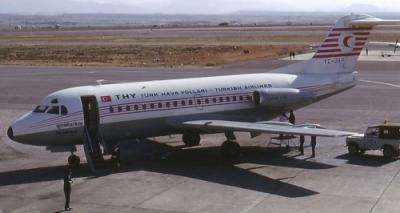Turkish Airlines Flight 345
 TC-JAP, the aircraft involved in the accident, photographed on 1 January 1975. | |
| Accident summary | |
|---|---|
| Date | 30 January 1975 |
| Summary | Impacted Sea of Marmara during go-around |
| Site |
Sea of Marmara, Turkey 40°44′50″N 28°39′58″E / 40.7472°N 28.666°ECoordinates: 40°44′50″N 28°39′58″E / 40.7472°N 28.666°E |
| Passengers | 38 |
| Crew | 4 |
| Fatalities | 42 (all) |
| Survivors | 0 |
| Aircraft type | Fokker F28-1000 Fellowship |
| Aircraft name | Bursa |
| Operator | Turkish Airlines |
| Registration | TC-JAP |
| Flight origin | Izmir Cumaovası Airport, Izmir, Turkey |
| Destination | Istanbul Yeşilköy Airport, Istanbul, Turkey |

Turkish Airlines Flight 345 was a scheduled domestic passenger flight operated by a Fokker F28-1000 Fellowship from Izmir Cumaovası Airport to Istanbul Yeşilköy Airport that crashed into the Sea of Marmara on 30 January 1975 during approach. It was the second worst accident involving a Fokker F28 and third deadliest aviation accident in Turkey at that time.
Background
The aircraft operating flight 345 was a Fokker F28 Fellowship 1000 powered by two Rolls-Royce "Spey" RB.183 turbofan engines. It was built by Fokker with manufacturer serial number 11058 and made its first flight in 1972. Since then, it had accumulated 3713 flying hours in 5062 flight cycles. With 38 passengers and 4 crew members on board, Flight 345 took off from Izmir Cumaovası Airport at around 18:00 EET (20:00 UTC) for a 40-minute flight to Istanbul Yeşilköy Airport.[1][2]
Accident
At 18:39, the aircraft touched down on the runway at Istanbul Yeşilköy Airport but an electrical power failure at the airport at that very moment forced the crew to initiate a missed approach. Twenty-two seconds after the lights went off, the emergency generator jumped in and restored the runway lights. The pilot elected to remain VFR under an altitude of 240 metres (790 ft). At 18:43, the crew asked for permission to land while positioning for another approach. However, because another aircraft, a Pan American World Airways Boeing 747, was about to take off, air traffic control ordered the crew of Flight 345 to fly an extended downwind leg. When, at 18:53, air traffic control attempted to establish contact with flight 345, it received no answer.[1]
It was determined that the aircraft crashed into the Sea of Marmara. However, the wreckage could not be located until several years later.[3]
Recovery
The relatives of the victims continuously demanded, without success, the recovery of the wreckage and the bodies of the victims from the sea floor.[3] A 3 m (9.8 ft) by 3 m (9.8 ft) 200 kg (440 lb) portion from the rear fuselage with five window frames was recovered on March 17, 2009 by shrimp trawling fishermen off the Avcılar-Florya coast. The finding was handed over to Turkish Airlines after inspection by Stuart Kline, an American historian of aviation living in Turkey.[4][5]
References
- 1 2 "Kara kutunun peşinde 36 yıl" (in Turkish). Sabah. Retrieved 4 June 2014.
- ↑ "Aircraft accident Fokker F-28 Fellowship 1000 TC-JAP Istanbul-Yeşilköy Airport (IST) [Marmara Sea]". Aviation Safety Network. Retrieved 2009-10-03.
- 1 2 "Korkunç iddia! Stuart Kline; Devlet 'sus payı' alarak kazanın üzerini örttü! THY derhal yanıtla ve çıkart!" (in Turkish). Hürriyet Port. 2009-06-15. Archived from the original on 2009-06-16.
- ↑ "Tarihi uçak balıkçı ağına takıldı" (in Turkish). Haber 24. 2009-03-18. Archived from the original on 2012-02-27.
- ↑ "35 Yıllık Kalıntı Günyüzüne Çıktı" (in Turkish). Deniz Haber. Retrieved 2009-10-03.